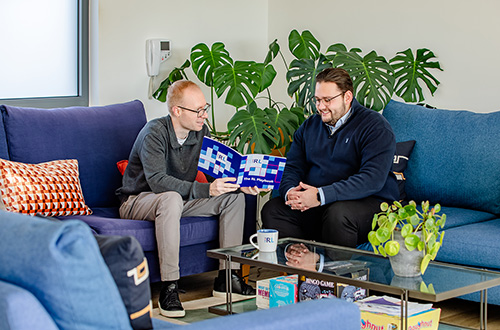The world of capital allowances has been something of a lottery in the last few years. We’ve had our tickets at the ready and our eye on the top prize but we’ve never been quite sure whether we would win or lose once the numbers were drawn.
In recent years, we’ve had new allowances such as the super deduction as well as changes to existing allowances. Main pool writing down allowances have fallen from 20% to 18%, and the special rate pool allowances have also dropped from 8% to 6%. Although the Annual Investment Allowance has been with us since 2008, we have always been told that it is only a ‘temporary’ allowance (until now) leaving taxpayers unsure from year to year whether it would be renewed or not. Its annual threshold has also been an area of uncertainty and it is only with hindsight that we can see it has, on the whole, gradually increased from £50K from its first introduction to the £1m we have today. Fortunately this year the Chancellor announced that the Annual Investment Allowance and its £1m threshold is to become permanent, but that of course may change with the next Budget or government.
The constant changes have caused uncertainty for businesses, meaning that they have often rushed to invest in assets before an allowance is expected to be removed or a threshold reduced, or have held back when expenditure has reached a permitted annual limit. Whilst this uncertainty may have encouraged short- term investment, the lack of clarity and unpredictability has made longer term investment planning very difficult.
So now, from April 2023, we have Full Expensing to add to the capital allowances armoury. What is this relief? Why do we need it? Who can claim it? What else do you need to know?
What are capital allowances?
Let’s start at the beginning. By way of background, when businesses buy capital assets they are only able to claim tax relief for that expenditure by claiming capital allowances. There are strict rules which set out the types of allowances that can be claimed.
Each allowance provides for its own rate of relief, with some only offering 3% relief each year (meaning that it can take many years to obtain full relief for that expenditure) while others allow 100% relief straight away. Normally, businesses will want to apply the allowance that gives them the highest and fastest rate of relief.
The type of allowance claimable can depend upon the type of asset purchased, the amount the business has invested in the year and whether the asset has any ‘green’ credentials.
What is Full Expensing?
Full Expensing is a new capital allowance which enables companies to claim 100% corporation tax relief in the year of expenditure on new qualifying ‘plant and machinery’. It is in fact a new type of 100% First Year Allowance.
Also issued alongside Full Expensing is a new 50% First Year Allowance for ‘special rate’ expenditure.
Who can claim the new allowances?
Only companies can claim the new allowances. Sole traders and partnerships will have to continue to rely on other capital allowances.
When can they claim?
The new allowances can be claimed on expenditure incurred between 1 April 2023 and 31 March 2026.
For these purposes, the expenditure is generally treated as ‘incurred’ on the date the obligation to pay becomes unconditional (normally being the date of delivery). This is different from the super- deduction rules which enabled a claim to be made once the purchaser was contractually bound to buying the asset.
Unfortunately the new allowances are only temporary, although the Chancellor has expressed a desire to make them permanent at some point in the future.
Why do we need Full Expensing?
Full Expensing has been brought in to effectively replace the super-deduction which ended in March 2023. This was a capital allowance that gave 130% relief for certain types of expenditure. The super-deduction was primarily designed as a temporary measure to prevent businesses delaying expenditure to the time when the corporation tax rate would rise to 25% (in April 2023).
Both allowances effectively give the same rate of relief. For example, plant costing £100K would have had relief of approximately £25K under the super deduction (being £100K x 130% x a corporation tax rate of 19%) and will now also have roughly £25K under the Full Expensing rules (being £100K x a corporation tax rate of 25%).
Alongside Full Expensing we continue to have the Annual Investment Allowance (AIA). This also provides for 100% relief for expenditure on qualifying plant, and its scope is wider than ‘Full Expensing’ as many more types of assets will qualify for the AIA. The main disadvantage of the AIA is that an expenditure threshold of £1m pa applies, whereas there is no limit to the expenditure that can qualify for Full Expensing relief. Furthermore, groups of companies are only entitled to one £1m AIA threshold to share between them, whereas there is no group restriction for Full Expensing relief.
What assets are eligible for Full Expensing relief?
The types of assets that qualify for Full Expensing relief are almost identical to those that qualified under the super-deduction rules. Broadly these are:
- plant and machinery (this is often used as a generic term to include the assets mentioned below as well as more traditional plant and machinery)
- computer equipment such as laptops, printers and servers
- commercial vehicles such as lorries and vans (but not cars)
- office equipment such as chairs and desks.
What assets qualify for the new 50% First Year Allowance?
The new 50% First Year Allowance applies to special rate assets, such as integral features. These include hot and cold water systems, electrical systems and ventilation systems.
Which assets do not qualify for the new allowances?
Assets that are ‘used’ or ‘second hand will not be eligible for the new allowance. Essentially this means that they must be brand new and must not have had a previous owner. HMRC accepts that they will still qualify if they have undergone some limited use for the purpose of testing, delivery or demonstration. Fortunately the AIA is still available for second hand assets.
The allowances do not apply to capital expenditure on assets the business itself won’t be using in its trade but which it will be leasing out (whether within the group or otherwise). However, there is an exception for ‘background plant and machinery’ which is leased together with a building under a mixed lease (such as heating and electrical systems, lifts, fitted cupboards and demountable partitions installed in the building). Nevertheless, the AIA can still be claimed on leased assets, so this does provide some leeway for businesses.
Although cars do not qualify for the new allowances (or for the AIA) a different 100% First Year Allowance can be claimed instead if the car has zero CO2 emissions and is both new and unused. If not, the rate of allowance is determined by the car’s CO2 emissions. The lower the CO2 emissions, the more generous the allowance. Currently, cars with CO2 emissions are 50g/km or less are eligible for a writing down allowance of 18%. This falls to 6% where CO2 emissions exceed 50 g/km.
Also, if you’re acquiring the equipment from another group company or a ‘connected person’ you won’t be able to claim the new allowances either (nor can you claim the AIA). However if that connected person’s ‘ordinary course of business’ is to manufacture or supply that type of equipment you may still be able to claim.
Is there any clawback of the relief on disposal?
Yes, if the asset is sold, a balancing charge will arise on disposal.
Where the 100% Full Expensing allowance has been claimed on the entire expenditure, the balancing charge will be equal to the proceeds received (provided they do not exceed the original cost).
Where the 100% allowance has been claimed on only part of the expenditure, a balancing charge will arise on the ‘relevant proportion’ of the disposal value. This is calculated as (A / B) x P where:
- A is the amount of expenditure for which the new allowance has been claimed
- B is the total amount of expenditure for which the new allowance could have been claimed
- P is the disposal proceeds.
Where the 50% First Year Allowance has been claimed A is divided by 2.
The remaining balance of the disposal proceeds is then deducted from either the main pool or the special rate pool, depending on the type of asset.
For example, a company incurs £100K on qualifying plant and claims 100% Full Expensing relief on £75K and the AIA on the remaining £25K. In a couple of years’ time it sells the plant for £10K. A balancing charge arises of £7.5K (being £75K expenditure for which the allowance has been claimed, divided by £100K total expenditure, multiplied by £10K sales proceeds). The remaining proceeds of £2.5K are then deducted from the main pool.
Companies claiming the new allowances will therefore need to keep track of the cost of each of those assets, the amount of allowance claimed and match this to the sales proceeds on disposal.
What else do I need to know?
The company can choose how much of the expenditure it wishes to claim allowances on. Any balance unclaimed can be added to the relevant pool and allowances claimed on that part in the usual way.
The allowances must be claimed in the year the expenditure is incurred. It is not possible to carry it forward to claim in a future year.
Can I claim both the new allowance and the AIA on the same expenditure?
It is not possible to claim the new allowance and the AIA on the same expenditure. However it is possible to claim AIA on part of the expenditure and the allowance on the remainder.
For most businesses, the AIA will be sufficient to cover provide 100% relief for the assets purchased. However, where the AIA has been exhausted, the new allowances can be claimed on the remaining part of the expenditure.
For example, where a company acquires a qualifying asset costing £100K and has only £50K AIA left, it should allocate that £50K AIA against the cost. First year allowances can then be claimed on the remaining balance of £50K, at a rate of either 100% or 50% depending on the type of asset.
When should you claim Full Expensing and when should you choose AIA?
Each case will depend on the specific circumstances, but as a general rule if all expenditure is under the AIA £1m threshold, it will probably be easier to claim the AIA rather than the new allowances. This is because there is no need to keep track of the allowances claimed on each asset and to carry out potentially complicated clawback calculations on disposal. Where the AIA has been claimed, disposal proceeds are simply deducted from the relevant pool (restricted to original cost) and will not necessarily lead to a balancing charge.
Where expenditure is over the £1m AIA threshold the claim could be made as follows:
- AIA on second hand assets
- AIA on assets acquired for leasing
- AIA on special rate assets
- the new allowances on everything else.
One further point to note is that companies with a year-end straddling 31 March 2023 may make a tax saving by deferring qualifying expenditure to the next accounting period. This is because the corporation tax rate rose from 19% to a full rate of 25% on 1 April 2023. Companies with an accounting period straddling this date therefore pay corporation tax at 19% on apportioned profits to 31 March 2023 and 25% on profits thereafter, leading to a ‘hybrid’ rate for the year which falls somewhere between 19% and 25%. Delaying investment until the following accounting period could mean that capital allowances are claimed in a year when the company saves corporation tax at 25% rather than a lower hybrid rate.
Of course if the accounting year end is approaching very soon (e.g 30 June) then the benefit of that deferral will be greater because a significant proportion of profits for that year will be taxed at 19%. Also, in terms of cash flow, a company with a June year end would not need to defer the expenditure for very long (as the new accounting year starts on 1 July). Companies with a December year- end on the other hand would have to defer expenditure for much longer (until 1 January) and the tax savings would not be so great.
What are the deferred tax implications?
One accounting point to mention is that the new rules are likely to either increase a company’s deferred tax liability or reduce its deferred tax asset shown in its financial statements.
This is because when the accounting net book value of an asset exceeds its tax written down value, a deferred tax liability arises. The new allowances are likely to provide for a faster rate of tax relief than the corresponding depreciation in the company’s accounts, thereby causing the tax written down value to be significantly lower than net book value.
What impact will the new allowances have?
With the AIA now permanently set at £1m per annum, it is likely to be sufficient to provide full relief for the vast majority of businesses. Full expensing and the new 50% allowance will mostly be of benefit to larger companies with higher levels of investment expenditure
As for unincorporated businesses, most of these will incur expenditure below the £1m AIA threshold and so their exclusion from the new allowances should not cause too much hardship. However certain types of businesses, such as farming partnerships, commonly spend more than £1m on farming equipment and so are likely to feel unfairly penalised by the new rules.
What is the timeframe for claiming the allowances?
The window for claiming the right capital allowances is narrow. Companies only have two years from the end of the accounting period to make a capital allowances claim, or an adjustment to a previous claim. Unfortunately HMRC does not accept older claims for changes to capital allowances under the ‘overpayment relief’ rules so there is no scope to go further back.
Claiming the right type of capital allowance in good time is therefore critical.
Clearly, things are not getting any easier for taxpayers. Finding an adviser who understands these rules, keeps you compliant and optimises your claims is more important than ever.
If you have any questions about the above, or would like more information specific to your circumstances, please enter your email address below and we will get in touch:
















